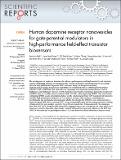| dc.contributor.author | Park, Seon Joo | |
| dc.contributor.author | Song, Hyun Seok | |
| dc.contributor.author | Kwon, Oh Seok | |
| dc.contributor.author | Chung, Ji Hyun | |
| dc.contributor.author | Lee, Seung Hwan | |
| dc.contributor.author | An, Ji Hyun | |
| dc.contributor.author | Ahn, Sae Ryun | |
| dc.contributor.author | Lee, Ji Eun | |
| dc.contributor.author | Yoon, Hyeonseok | |
| dc.contributor.author | Park, Tai Hyun | |
| dc.contributor.author | Jang, Jyongsik | |
| dc.date.accessioned | 2014-07-08T20:39:41Z | |
| dc.date.available | 2014-07-08T20:39:41Z | |
| dc.date.issued | 2014-03 | |
| dc.date.submitted | 2013-12 | |
| dc.identifier.issn | 2045-2322 | |
| dc.identifier.uri | http://hdl.handle.net/1721.1/88219 | |
| dc.description.abstract | The development of molecular detection that allows rapid responses with high sensitivity and selectivity remains challenging. Herein, we demonstrate the strategy of novel bio-nanotechnology to successfully fabricate high-performance dopamine (DA) biosensor using DA Receptor-containing uniform-particle-shaped Nanovesicles-immobilized Carboxylated poly(3,4-ethylenedioxythiophene) (CPEDOT) NTs (DRNCNs). DA molecules are commonly associated with serious diseases, such as Parkinson's and Alzheimer's diseases. For the first time, nanovesicles containing a human DA receptor D1 (hDRD1) were successfully constructed from HEK-293 cells, stably expressing hDRD1. The nanovesicles containing hDRD1 as gate-potential modulator on the conducting polymer (CP) nanomaterial transistors provided high-performance responses to DA molecule owing to their uniform, monodispersive morphologies and outstanding discrimination ability. Specifically, the DRNCNs were integrated into a liquid-ion gated field-effect transistor (FET) system via immobilization and attachment processes, leading to high sensitivity and excellent selectivity toward DA in liquid state. Unprecedentedly, the minimum detectable level (MDL) from the field-induced DA responses was as low as 10 pM in real- time, which is 10 times more sensitive than that of previously reported CP based-DA biosensors. Moreover, the FET-type DRNCN biosensor had a rapid response time (<1 s) and showed excellent selectivity in human serum. | en_US |
| dc.language.iso | en_US | |
| dc.publisher | Nature Publishing Group | en_US |
| dc.relation.isversionof | http://dx.doi.org/10.1038/srep04342 | en_US |
| dc.rights | Creative Commons Attribution-Noncommercial-Share Alike | en_US |
| dc.rights.uri | http://creativecommons.org/licenses/by-nc-sa/3.0 | en_US |
| dc.source | Nature Publishing Group | en_US |
| dc.title | Human dopamine receptor nanovesicles for gate-potential modulators in high-performance field-effect transistor biosensors | en_US |
| dc.type | Article | en_US |
| dc.identifier.citation | Park, Seon Joo, Hyun Seok Song, Oh Seok Kwon, Ji Hyun Chung, Seung Hwan Lee, Ji Hyun An, Sae Ryun Ahn, et al. “Human Dopamine Receptor Nanovesicles for Gate-Potential Modulators in High-Performance Field-Effect Transistor Biosensors.” Sci. Rep. 4 (March 11, 2014). | en_US |
| dc.contributor.department | Institute for Medical Engineering and Science | en_US |
| dc.contributor.department | Harvard University--MIT Division of Health Sciences and Technology | en_US |
| dc.contributor.department | Massachusetts Institute of Technology. Department of Chemistry | en_US |
| dc.contributor.mitauthor | Song, Hyun Seok | en_US |
| dc.contributor.mitauthor | Kwon, Oh Seok | en_US |
| dc.relation.journal | Scientific Reports | en_US |
| dc.eprint.version | Final published version | en_US |
| dc.type.uri | http://purl.org/eprint/type/JournalArticle | en_US |
| eprint.status | http://purl.org/eprint/status/PeerReviewed | en_US |
| dspace.orderedauthors | Park, Seon Joo; Song, Hyun Seok; Kwon, Oh Seok; Chung, Ji Hyun; Lee, Seung Hwan; An, Ji Hyun; Ahn, Sae Ryun; Lee, Ji Eun; Yoon, Hyeonseok; Park, Tai Hyun; Jang, Jyongsik | en_US |
| mit.license | PUBLISHER_CC | en_US |
| mit.metadata.status | Complete | |
